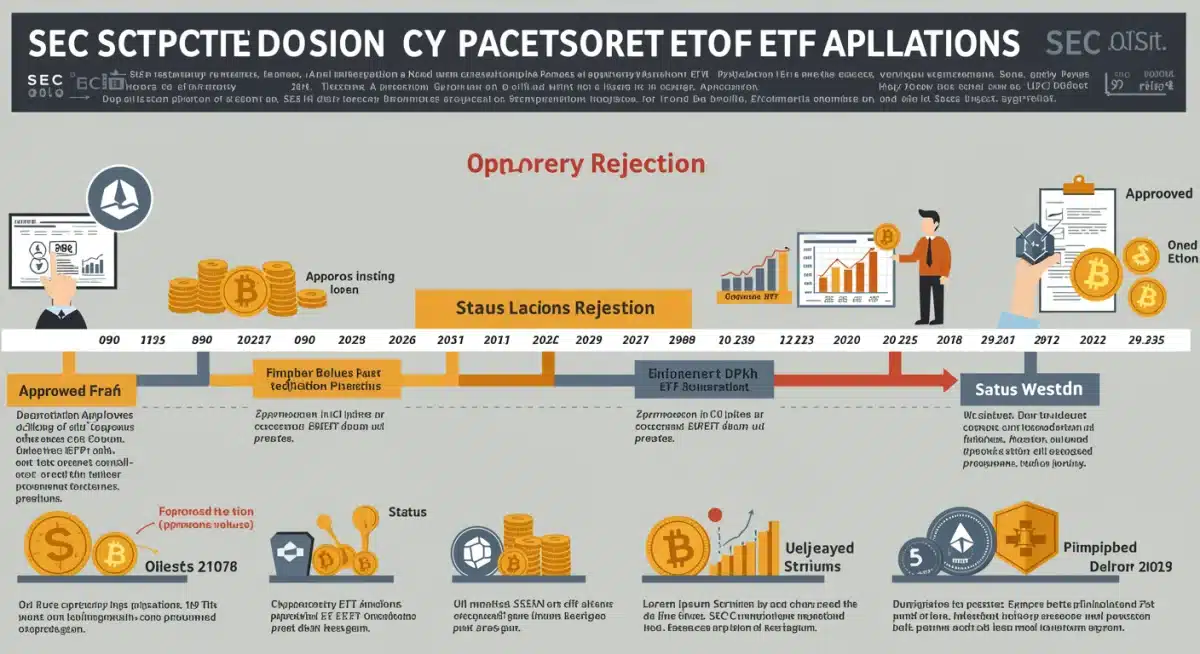SEC Crypto ETFs: US Digital Economy 2025 Impact

Latest developments on Understanding the SEC’s New Stance on Crypto ETFs: Implications for U.S. Digital Economy in 2025 (RECENT UPDATES) with key facts, verified sources, and what readers need to monitor next in the United States, presented clearly in English (United States).
Understanding the SEC’s New Stance on Crypto ETFs: Implications for U.S. Digital Economy in 2025 (RECENT UPDATES) is shaping today’s agenda with new details emerging from officials and industry sources. This update prioritizes what changed, why it matters, and what to watch next, in a clear news format.
The evolving landscape of SEC crypto ETF regulation
The Securities and Exchange Commission (SEC) has recently intensified its scrutiny and adjusted its regulatory approach towards cryptocurrency Exchange Traded Funds (ETFs). This shift marks a pivotal moment for the digital asset industry, particularly as we approach 2025. The SEC’s evolving stance reflects a growing recognition of crypto assets within traditional financial markets, yet it continues to emphasize investor protection and market integrity.
For years, the approval of a spot Bitcoin ETF remained an elusive goal for many applicants, met with consistent rejections by the SEC due to concerns over market manipulation, custody, and valuation. However, recent approvals for certain Bitcoin spot ETFs have signaled a potential turning point, prompting a re-evaluation of the regulatory framework for other digital assets.
Key regulatory shifts and approvals
- Spot Bitcoin ETF Approval: The landmark approval of several spot Bitcoin ETFs in early 2024 significantly altered market expectations and paved the way for broader institutional adoption. This decision followed extensive legal battles and evolving market surveillance agreements.
- Ether Futures ETF Approvals: Alongside Bitcoin, the SEC has also greenlighted Ether futures ETFs, indicating a willingness to consider derivatives-based crypto products within existing regulatory frameworks.
- Enhanced Scrutiny for Other Assets: While Bitcoin and Ether have seen some progress, the SEC maintains a cautious approach to ETFs linked to other cryptocurrencies, often citing concerns about their classification as securities and the maturity of their underlying markets.
This evolving regulatory posture is not merely a bureaucratic exercise; it has tangible consequences for how digital assets are integrated into the U.S. financial system and, by extension, the broader digital economy. The implications extend beyond just investment products, touching upon market structure, innovation, and global competitiveness.
Implications for the U.S. digital economy in 2025
The SEC’s stance on crypto ETFs is set to profoundly influence the U.S. digital economy as 2025 unfolds. This regulatory clarity, or lack thereof for some assets, directly impacts investment flows, technological innovation, and the competitive landscape for financial institutions and crypto firms. The mainstreaming of crypto investment vehicles could unlock significant capital, but also introduces new layers of oversight.
The digital economy thrives on innovation and accessible capital. When the SEC provides clearer guidelines, it can legitimize asset classes, attracting more traditional investors and fostering a more robust ecosystem. Conversely, ambiguity or overly restrictive policies can stifle growth and push innovation offshore. This dynamic is particularly evident in the current environment, where the U.S. aims to balance leadership in digital finance with strong regulatory safeguards.
Impact on institutional investment and market access
The approval of spot Bitcoin ETFs has already democratized access to Bitcoin for traditional investors, allowing them to gain exposure without directly holding cryptocurrencies. This expanded access is expected to continue into 2025, potentially drawing billions in new capital into the crypto market. Institutional investors, who previously faced significant hurdles, can now allocate funds more easily through regulated investment products.
Furthermore, the increased participation from institutional players is likely to enhance market liquidity and stability. As more regulated entities enter the space, market surveillance and transparency are expected to improve, addressing some of the SEC’s long-standing concerns regarding market integrity. This institutional embrace could also lead to the development of more sophisticated financial products built around digital assets.
However, this also means that financial advisors and wealth managers will need to become more knowledgeable about these products, as their clients increasingly seek exposure to crypto assets. Educational initiatives and clear communication from both regulators and product providers will be crucial to ensure informed investment decisions.

Challenges and opportunities for crypto innovation
The SEC’s regulatory framework, while bringing clarity to some areas, also presents significant challenges and opportunities for innovation within the crypto space. The strict requirements for ETF approvals, particularly concerning custody, valuation, and market surveillance, push crypto firms to enhance their operational standards and integrate with traditional financial infrastructure. This pressure can lead to more mature and secure crypto products and services.
On one hand, the regulated pathway of ETFs could accelerate the development of compliant blockchain solutions and digital asset platforms. Companies striving to meet SEC standards are likely to invest heavily in robust security protocols, transparent reporting mechanisms, and sophisticated risk management systems. This could ultimately benefit the entire ecosystem by elevating industry best practices.
On the other hand, the focus on specific, well-established cryptocurrencies like Bitcoin and Ether for ETF approvals might inadvertently slow down innovation for newer, less mature digital assets. Projects focused on novel blockchain applications or alternative consensus mechanisms might find it harder to gain regulatory traction or secure mainstream investment if they don’t fit neatly into existing regulatory boxes. This creates a dichotomy where established assets gain legitimacy, while emerging ones face an uphill battle for recognition.
Navigating the regulatory maze for new assets
- Security vs. Commodity Debate: The ongoing debate about whether certain cryptocurrencies are securities or commodities remains a significant hurdle. The SEC’s classification dictates the regulatory body (SEC or CFTC) and the applicable rules, creating uncertainty for developers and investors.
- Lack of Clear Framework for DeFi: Decentralized Finance (DeFi) protocols, which operate without traditional intermediaries, present a unique challenge for regulators. The SEC has yet to provide a comprehensive framework for DeFi, potentially limiting its integration into regulated financial products like ETFs.
- Global Regulatory Harmonization: The U.S. regulatory approach does not exist in a vacuum. Discrepancies between U.S. regulations and those in other major financial hubs can create arbitrage opportunities or push innovative projects to more crypto-friendly jurisdictions.
Ultimately, the SEC’s posture encourages a more deliberate and compliant approach to crypto innovation. While this might temper the rapid, often unregulated, development seen in earlier years, it could foster a more sustainable and integrated digital asset ecosystem in the long run.
The role of investor protection in SEC decisions
Investor protection remains a cornerstone of the SEC’s mandate, and this principle heavily influences its decisions regarding crypto ETFs. The Commission has consistently voiced concerns about market manipulation, fraud, and the lack of robust investor safeguards in the nascent crypto markets. These concerns have historically driven the cautious approach to approving crypto-related financial products.
With the recent approvals, the SEC has indicated that certain conditions, such as comprehensive surveillance-sharing agreements with regulated markets, have been met to address these risks for specific assets. These agreements are designed to detect and deter fraudulent and manipulative acts and practices, thereby safeguarding investors who participate in these ETFs.
However, the SEC’s diligence extends beyond just market integrity. It also encompasses ensuring that investors receive adequate disclosure about the risks associated with investing in crypto ETFs. This involves clear and concise prospectus information, highlighting the volatility of digital assets, potential custody risks, and the speculative nature of these investments.
As the market matures, the focus on investor education will likely intensify. The SEC, in collaboration with financial advisors and industry groups, will need to provide resources that help both retail and institutional investors understand the complexities and risks inherent in crypto investments. This proactive approach to education is vital for preventing widespread financial harm and building long-term trust in digital asset markets.
Market structure and liquidity enhancements
The introduction of SEC-approved crypto ETFs is expected to bring significant enhancements to market structure and liquidity within the digital asset ecosystem. By bridging the gap between traditional finance and crypto, these products facilitate smoother capital flows and potentially reduce price volatility. The increased participation of regulated entities and traditional market makers can deepen liquidity pools, making it easier and more efficient to trade underlying assets.
ETFs are inherently designed to provide liquidity, allowing investors to buy and sell shares throughout the trading day on major exchanges. This mechanism can reduce the impact of large buy or sell orders on the underlying crypto asset’s price, contributing to a more stable market environment. Furthermore, the transparency requirements associated with ETFs, such as daily disclosure of holdings, can increase overall market transparency.
The integration of crypto assets into established market infrastructures also brings sophisticated trading technologies and risk management practices. Traditional financial institutions often leverage advanced algorithms and high-frequency trading strategies that can contribute to tighter spreads and more efficient price discovery. This professionalization of crypto trading through ETFs could attract even more institutional capital, creating a virtuous cycle of liquidity and market efficiency.
However, the impact on market structure is not without its complexities. The concentration of trading volume in a few highly liquid ETFs could potentially overshadow direct spot trading on unregulated exchanges, leading to a shift in market dynamics. Regulators will need to monitor these shifts to ensure fair competition and prevent undue market dominance by a few large players.

Global competitiveness and regulatory arbitrage
The SEC’s approach to crypto ETFs has direct implications for the U.S.’s position in the global digital economy. As other jurisdictions, notably in Europe and Asia, have moved more quickly to approve various crypto ETPs (Exchange Traded Products), the U.S. has faced criticism for lagging. Recent approvals, however, suggest a renewed effort by the U.S. to regain its competitive edge in this rapidly expanding sector.
A clear and predictable regulatory environment for crypto ETFs can attract international capital and foster domestic innovation, positioning the U.S. as a leader in digital asset finance. Conversely, overly burdensome or ambiguous regulations could lead to regulatory arbitrage, where businesses and investors seek more favorable environments abroad. This phenomenon can result in a brain drain of talent and capital, hindering the growth of the U.S. digital economy.
The global nature of cryptocurrency markets means that regulatory decisions in one major jurisdiction can have ripple effects worldwide. As the U.S. clarifies its stance, it sets a precedent that other countries may consider. This could lead to a more harmonized global regulatory landscape, or it could exacerbate existing divergences, depending on the specifics of the SEC’s future actions.
Therefore, the SEC’s decisions are not just about domestic market health; they are also about maintaining the U.S.’s strategic advantage in the global race for digital finance dominance. Policymakers and regulators must carefully weigh investor protection against the imperative to foster innovation and maintain competitiveness on the international stage.
Future outlook: potential for broader crypto ETF offerings
Looking ahead to 2025 and beyond, the recent SEC approvals for Bitcoin spot ETFs and Ether futures ETFs raise questions about the potential for broader crypto ETF offerings. While the path for other cryptocurrencies remains less clear, the precedent set by Bitcoin and Ether approvals could open doors for other digital assets, provided they meet stringent regulatory requirements.
The SEC is likely to continue its asset-by-asset evaluation, focusing on the maturity of the underlying market, the existence of robust surveillance mechanisms, and the clarity of the asset’s legal classification. Cryptocurrencies with significant market capitalization, strong institutional interest, and clear regulatory pathways might be the next in line for consideration. However, the process is expected to be gradual and highly scrutinized.
Furthermore, the development of new types of crypto ETFs, such as those tracking baskets of digital assets or inverse ETFs that profit from price declines, could also emerge. These products would cater to a wider range of investment strategies, offering more sophisticated tools for managing crypto exposure within a regulated framework. The demand from investors for diversified crypto exposure is undeniable, and the financial industry will continue to innovate to meet this demand.
Ultimately, the future of crypto ETFs in the U.S. rests on continued dialogue between regulators and the industry, technological advancements in market surveillance, and the evolving legal landscape surrounding digital assets. While progress has been made, the journey towards a fully integrated and diverse crypto ETF market is still underway, with 2025 poised to be a critical year for these developments.
Key Aspect |
Brief Description |
|---|---|
SEC Stance Evolution |
Shift from consistent rejections to recent approvals for Bitcoin spot and Ether futures ETFs. |
Digital Economy Impact |
Increased institutional investment, market liquidity, and potential for broader innovation. |
Investor Protection |
Central to SEC decisions, driving requirements for surveillance and clear disclosures. |
Future Outlook |
Gradual expansion to other crypto assets and new ETF types, contingent on regulatory clarity. |
Frequently Asked Questions about Crypto ETFs
The SEC’s primary concerns centered on market manipulation, the lack of surveillance-sharing agreements with significant regulated markets, and adequate investor protection. They also cited issues with asset custody and valuation in the largely unregulated spot crypto markets.
Recent approvals came after applicants established robust surveillance-sharing agreements with regulated exchanges, addressing the SEC’s market manipulation concerns. Legal challenges also played a role in compelling the SEC to re-evaluate its rationale for rejection, leading to a more favorable outcome.
Crypto ETFs provide a more accessible and regulated way for average investors to gain exposure to cryptocurrencies without directly managing digital assets. This simplifies investment, potentially reducing risks associated with direct crypto purchases and storage, and integrating crypto into traditional portfolios.
While Bitcoin and Ether have seen progress, the SEC is expected to continue its cautious, asset-by-asset approach. Approvals for other cryptocurrencies will likely depend on their market maturity, regulatory clarity regarding their classification, and the establishment of robust investor protection measures.
A clearer, more predictable regulatory environment for crypto ETFs can enhance U.S. competitiveness by attracting capital and fostering innovation. Conversely, overly restrictive policies could prompt businesses and investors to seek more crypto-friendly jurisdictions, potentially hindering domestic growth in the digital asset space.
What this means
The SEC’s recent shift in its approach to crypto ETFs signals a significant maturation of the digital asset market within the U.S. financial system. This development is not merely about new investment products; it represents a foundational change in how cryptocurrencies are perceived and integrated. As 2025 approaches, market participants should closely monitor further regulatory guidance, particularly concerning other digital assets, and observe the influx of institutional capital. These factors will collectively shape the trajectory of the U.S. digital economy, influencing innovation, investment strategies, and global financial leadership in the evolving crypto landscape.





